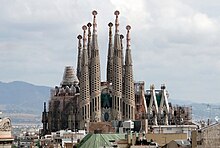Basílica i Temple Expiatori de la Sagrada Família
| Sagrada Família Basílica i Temple Expiatori de la Sagrada Família Templo Expiatorio de la Sagrada Familia Basilica and Expiatory Church of the Holy Family |
|
|---|---|

View of the Passion Façade (Western side) in September 2009
(cranes digitally removed) |
|
| Basic information | |
| Location | Barcelona, Catalonia, Spain |
| Geographic coordinates | 41°24′13″N 2°10′28″E / 41.40361°N 2.17444°ECoordinates: 41°24′13″N 2°10′28″E / 41.40361°N 2.17444°E |
| Affiliation | Roman Catholic |
| District | Barcelona |
| Country | Spain |
| Year consecrated | 7 November 2010 |
| Ecclesiastical or organizational status | Minor basilica |
| Status | Active/incomplete |
| Heritage designation | 1969, 1984 |
| Leadership | Archbishop Joan Josep Omella |
| Website | sagradafamilia |
| Architectural description | |
| Architect(s) | Antoni Gaudí |
| Architectural style | Modernisme |
| General contractor | Construction Board of La Sagrada Família Foundation |
| Groundbreaking | 1882 |
| Completed | 2026–2028 (2011 estimate) |
| Specifications | |
| Direction of façade | Southeast |
| Capacity | 9,000 |
| Length | 90 m (300 ft) |
| Width | 60 m (200 ft) |
| Width (nave) | 45 m (150 ft) |
| Spire(s) | 18 (8 already built) |
| Spire height | 170 m (560 ft) (planned) |
| Official name: Templo Expiatorio de la Sagrada Familia | |
| Type | Monument – Basilica |
| Designated | 24 July 1969 |
| Reference no. | (R.I.)-51-0003813-00000 |
| UNESCO World Heritage Site | |
| Official name | Works of Antoni Gaudí |
| Criteria | Cultural: (i), (ii), (iv) |
| Reference | 320-005 |
| Inscription | 1984 (8th Session) |
|
[]
|
|
|
|
The Basílica i Temple Expiatori de la Sagrada Família (Catalan pronunciation: [səˈɣɾaðə fəˈmiɫiə]; Spanish: Templo Expiatorio de la Sagrada Familia; English: Basilica and Expiatory Church of the Holy Family) is a large unfinished Roman Catholic church in Barcelona, designed by Catalan architect Antoni Gaudí (1852–1926). Gaudí's work on the building is part of a UNESCO World Heritage Site, and in November 2010 Pope Benedict XVI consecrated and proclaimed it a minor basilica, as distinct from a cathedral, which must be the seat of a bishop.
In 1882, construction of Sagrada Família commenced under architect Francisco Paula de Villar. In 1883, when Villar resigned, Gaudí took over as chief architect, transforming the project with his architectural and engineering style, combining Gothic and curvilinear Art Nouveau forms. Gaudí devoted the remainder of his life to the project, and at the time of his death at age 73 in 1926, less than a quarter of the project was complete.
Relying solely on private donations, Sagrada Familia's construction progressed slowly and was interrupted by the Spanish Civil War, only to resume intermittent progress in the 1950s. Since commencing construction in 1882, advancements in technologies such as computer aided design and computerised numerical control (CNC) have enabled faster progress and construction passed the midpoint in 2010. However, some of the project's greatest challenges remain, including the construction of ten more spires, each symbolising an important Biblical figure in the New Testament. It is anticipated that the building could be completed by 2026—the centenary of Gaudí's death.
...
Wikipedia
